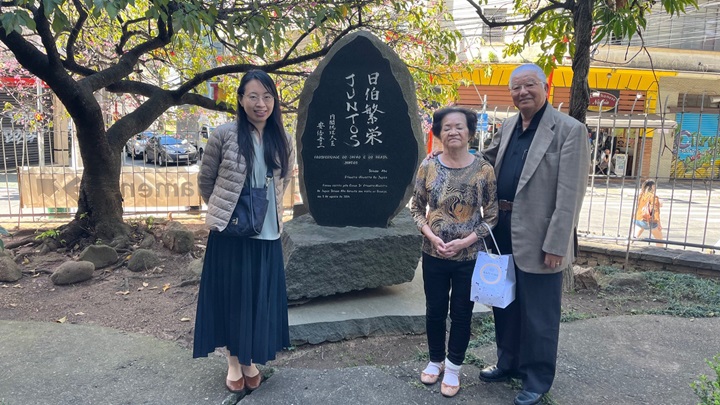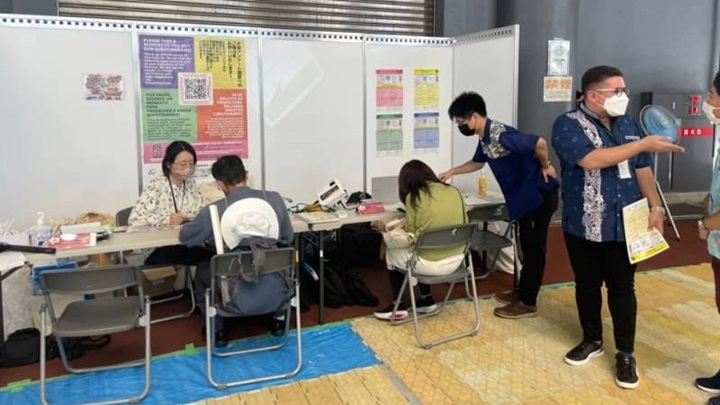Interview With Visiting Fellow Nagamura Yukako: Revisiting the Connections Between Latin America and Japan Beyond History and Geographical Areas
2025.07.09
From before World War II (WWII), after WWII and up until today, there has been a continuous movement of people between Latin American diasporas of the Nikkei (Japanese emigrants and their descendants) and Japan. To understand the strong connection between post-WWII Japanese society and Nikkei diasporas in Latin America, the JICA Ogata Sadako Research Institute for Peace and Development (JICA Ogata Research Institute) has been conducting the research project “A Study on the Movement and Networks of Japanese Migrants and Their Descendants Between Japan and Latin America ” since 2021. Nagamura Yukako , Visiting Fellow, the JICA Ogata Research Institute, is the chief of this project. (Read this article from when she was interviewed at the time the research project was launched.) This year, “The History of Movement and Nikkei Roots: Strong Bonds and Culture Seen from the Experience of Migration and ‘Returning’,” a book (available in Japanese only) that compiles the findings of this research project will be published. We asked Nagamura about the significance and real thrill of this research project, the key message she is hoping to convey through the book and her future prospects.

─ Please share the outline of the research project and its findings.
In this research project, from broad perspectives in terms of historical timeline and geography, we are analyzing what connects the emigration from Japan to Latin America, today’s overseas Nikkei diasporas, and the communities of Nikkei people from Latin America who now reside in Japan. Generally speaking, historical research often focuses on a specific period of time in the past. However, this project is characterized by how it also looks at the connections with the present day while being aware of the long history leading up to the present. We therefore had the participation of more than 10 researchers with diverse backgrounds, including sociologists and historians, and while paying attention to changes from generation to generation, we thoroughly examined how Nikkei networks have been maintained and passed on.
As a result, we had many new findings. Let me share one example from Part I of the book. It was a huge achievement for us that we were able to reveal a new connection between the repatriation of Japanese citizens from the Korean Peninsula, Taiwan and Manchuria after WWII, and the migration to South America. In the great confusion after losing WWII, Japan saw a sharp increase in population. Food shortage and poverty became serious. As a result, migration to South America was encouraged as part of a national policy. Although it had been already known that some of these Japanese emigrants were repatriates from the geographies mentioned above, not much was known about them. This is because there were limited opportunities for researchers studying the former Empire of Japan and its territories to conduct studies in South America and vice versa, researchers working on the migration of Japanese people to South America, including myself, had limited knowledge of the post-WWII repatriation.
There is an expert of Japan-Manchuria migration in our research team, and I was able to visit South America with him. Many of the Japanese repatriates who moved to South America were still children when the war ended. From our study, we found out that the background of their fathers or other family members was diverse in the former Japanese territories, from government officials, employees of railway companies to agricultural workers, and many of them were hoping to be able to make the most of their life skills and expertise at their destination of migration. As such, for some of the migrants, the situation was different from the conventional perception of Japanese migrants moving to South America out of poverty and suffering. By combining the information different researchers could gather from their different expertise, we were able to reveal an unknown course of history. Through this experience of bringing together each other’s expertise, we realized that so much can be overlooked when research is separately conducted by individuals. This kind of discovery is the real thrill of this research project, which was conducted with the participation of various researchers offering a wide range of perspectives.

Visiting Fellow Nagamura (to the left) is with first-generation post-WWII Japanese immigrants in Brazil who had repatriated from Manchuria. Nagamura interviewed them as part of her work in Brazil.
─ What is most memorable about your research work in South America?
I would like to share about the migration of Japanese women to South America as an example. Several hundred women went to Brazil from Japan after WWII and most of them went there to marry Japanese men who had already migrated to Brazil as workforce in the agriculture sector. Nikkei Brazilian industry associations worked with Japanese prefectures and there was a structured system to recruit migrant brides. The term “migrant brides” may give the impression that these women had no other option but to migrate because they were suffering from poverty or had limited educational background. However, when we went to Brazil and interviewed them in person, it came clear that many of them had set their eyes on moving abroad because they were originally from large cities or had received good education.
When the Japanese economy started to develop after WWII, some women started to dream of living overseas. However, at the time, it was extremely difficult for most women to move abroad on their own.Therefore, as a means to be set free to the outside world, they chose marriage abroad. Of course, this does not mean that they were free from hardships and their lives have been full of ups and downs. Yet still, when we interviewed these women, it was very interesting as we were able to see that they took pride in how they made choices about their lives by themselves and overcame hardships. The detailed background of migrant brides who moved abroad after WWII is another area that was revealed by this research project.
─ What challenges did you face when conducting this research project?
When I was preparing my doctor’s thesis, all I had to do was to focus on my work. I was able to set my goals and schedule at my own pace. However, as the chief of this research project, I was in charge of all coordination work, and had to constantly keep an eye out on the work of other members and put everything together. This was challenging at times. However, by holding regular working group meetings to check the progress status of each other’s work and frequently facilitating communication between members, I think we were able to overcome barriers between different academic and geographical areas. For instance, researchers who used to conduct fieldwork only in South America became more knowledgeable of fieldwork in Japan, while researchers who had only worked in Japan started to show interest in the history of Latin America. To be honest there was pressure, but through this project, I was able to discover so many things that I would never have found on my own.
─ The book “The History of Movement and Nikkei Roots: Strong Bonds and Culture Seen from the Experience of Migration and ‘Returning’ (provisional title),” compiles the findings of this research project and will be published soon. Can you tell us a little about it?
I feel that by putting together the findings in the form of a book, the full picture of the four-year project has become visible. From migration studies as a form of historical studies, studies on Nikkei people from Latin America who live in Japan in the context of studying foreigners living in Japan, to studies on Nikkei diaspora around the world, areas of study that used to be cut off from each other are in fact deeply linked to each other. I carefully structured the book so that this message can be conveyed throughout, beyond history and geographical areas.
Part I “Overseas Migration of the Japanese and Their Experience” looks at the emigration of Japanese people before and after WWII, including migrant brides and emigrants who were repatriates from the territories of the Empire of Japan. Part II “Understanding the ‘Return’ Experience of the Nikkei People” explores the experience of those who “returned” to Japan from Nikkei communities in countries such as Peru and Brazil. Part III “The ‘Dekasegi’ Going Home and Nikkei Communities in South America” looks at the movement of the Nikkei who went back to Brazil or Peru from Japan, and Part IV “Forming Networks and Participating in Them” covers communities with roots in Ishikawa and Okinawa, Japan. The book has become extensive; there are 13 chapters in total, adding up to over 500 pages. However, I really feel that by building on each chapter, one by one, the full picture is finally becoming clear. The challenges that I experienced were different from when putting together collections of academic papers, but the process was enjoyable.

Okinawa used to send out many migrants overseas. The Worldwide Uchinanchu Festival, an event for people with Okinawan roots to come together from around the world, is held there every five years. In this photo, Nagamura conducts a survey at the seventh Worldwide Uchinanchu Festival.
I am eager to have those who are involved in history education take a look at our new book. As mentioned earlier, there is great value in how the connection between the repatriation of Japanese citizens and the migration to South America after WWII was revealed. In addition, the book is full of contents that lead us to new understandings both in terms of Japanese history and world history. For instance, the promotion of emigration under national policy was led at the prefecture level and especially in the case of Okinawa, the network from that time is still alive. I think this book can be read with ease, not only by graduate-school students but also by undergraduates. I hope a wide range of readers with an interest in history or the current situation of the Nikkei enjoy this book.
─ What are your future prospects?
Even the theme “Japanese repatriates and their migration to South America” alone requires further research and I am already looking forward to conducting further studies with experts from a wide range of fields. There are two aspects of historical studies: one is to go back in time, and the other is to look into the future. Let us look at the Nikkei people who are currently residing in Japan as an example. Their lives continue and are passed on to next generations, second, third and beyond. We need to continue to look at what gets passed on from previous generations and what becomes dropped. As generations go by, they may experience less hardships as immigrants but how would their identities change? Would their culture be passed down? There is a lot that I would like to know. As such, while the research theme may change gradually over time, I think that there never will be a full stop to my work. I want to continue to respect historicity. As long as I reflect on the past and continue to look into the present and the future, I will never run out of research topics.

事業事前評価表(地球規模課題対応国際科学技術協力(SATREPS)).国際協力機構 地球環境部 . 防災第一チーム. 1.案件名.国 名: フィリピン共和国.

事業事前評価表(地球規模課題対応国際科学技術協力(SATREPS)).国際協力機構 地球環境部 . 防災第一チーム. 1.案件名.国 名: フィリピン共和国.

事業事前評価表(地球規模課題対応国際科学技術協力(SATREPS)).国際協力機構 地球環境部 . 防災第一チーム. 1.案件名.国 名: フィリピン共和国.

事業事前評価表(地球規模課題対応国際科学技術協力(SATREPS)).国際協力機構 地球環境部 . 防災第一チーム. 1.案件名.国 名: フィリピン共和国.

事業事前評価表(地球規模課題対応国際科学技術協力(SATREPS)).国際協力機構 地球環境部 . 防災第一チーム. 1.案件名.国 名: フィリピン共和国.
scroll